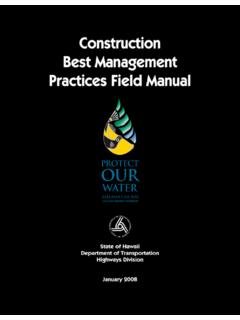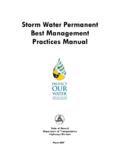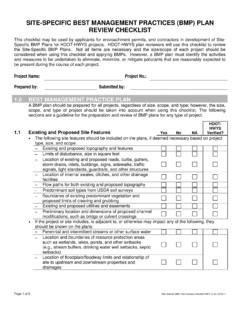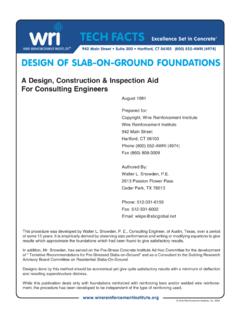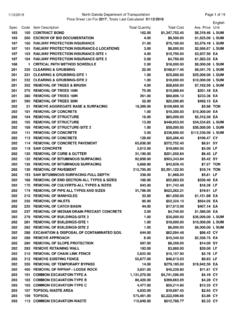Transcription of Silt Fence or Filter Fabric Fence - Storm Water Hawaii
1 State of Hawaii DOT, Highways Division Construction BMP Field Manual SC-1-1 January 2008 Silt Fence or Filter Fabric Fence SC-1 Source: Caltrans Construction Site Best Management Practices Manual, 2003. Description A sediment barrier composed of permeable geotextile Filter Fabric attached to supporting posts. Wire fencing may provide additional support. The silt Fence intercepts the flow of sediment laden runoff, which filters the Water and traps the sediment.
2 Applications Along the site perimeter. Around temporary stockpiles. Along streams and channels. Below the toe of cleared or erodible slopes. Downslope of exposed soil areas. Installation and Implementation Requirements Primarily use where sheet flow occurs. Install silt Fence along or parallel to contours. Ends of silt Fence shall be turned uphill and the geotextiles should be overlapped. Silt Fence posts shall be driven 14 inches minimum into the trench (see silt Fence detail) and the geotextile Filter Fabric shall be embedded a minimum of 6 inches vertically into the ground or install according to manufacturer s recommendation.
3 Limitations Avoid installing silt Fence on slope. However if silt Fence is placed on slope, Fence posts may need additional embedment. Do not install in streams, channels, or areas of concentrated flow. Do not use to divert flow. State of Hawaii DOT, Highways Division Construction BMP Field Manual SC-1-2 January 2008 Silt Fence or Filter Fabric Fence SC-1 Inspections and Maintenance Inspect weekly during dry periods as well as within 24 hours of any rainfall of inch or greater which occurs in a 24-hour period and daily during periods of prolonged rainfall.
4 Repair or replace damaged Fence or posts. Remove accumulated sediment when depth reaches 1/3 the barrier height. Silt Fence or Filter Fabric Fence SC-1 Source: Water Pollution and Erosion Control Details, Fort Weaver Road Widening Vicinity of Aawa Drive to Geiger Road, Depart of Transportation Highways Division, 2007. State of Hawaii DOT, Highways Division Construction BMP Field Manual SC-1-3 January 2008 NOTES: 1. THE Filter Fabric SHALL BE A MINIMUM OF 36 INCHES WIDE. 2. IF SILT Fence IS OBTAINED FROM MANUFACTURER AS A PACKAGE ( Fabric ATTACHED TO POST) THE MANUFACTURER S INSTALLATION INSTRUCTION SHALL BE ADHERED TO.
5 3. Fence STAKES MAY BE WOOD OR METAL, MUST BE CAPABLE OF SUPPORTING ANTICIPATED LOADS. GEOTEXTILE Filter Fabric BURY BOTTOM OF GEOTEXTILE Filter Fabric IN 6 X 6 TRENCH GEOTEXTILE Filter Fabric Fence STAKEBACKFILL AND COMPACT THE EXCAVATED SOIL IN TRENCH Fence STAKE SILT Fence NTS State of Hawaii DOT, Highways Division Construction BMP Field Manual SC-5-1 January 2008 Vegetated Buffer Strips and Channels SC-5 Source.
6 Modified from Knoxville BMP Manual, 2003. Description Vegetative buffer strips and channels protect soil from erosion, increase infiltration, and remove sediment from surface runoff. Located adjacent to pollutant sources such as construction sites, vegetated buffer strips also provide protection to downstream receiving inlets or Water bodies. Applications Any site which is suitable for establishment of vegetation. Vegetated buffer strips are appropriate for uncurbed, paved areas; steep and potentially unstable slopes; and areas adjacent to sensitive Water bodies.
7 Vegetated channels are appropriate for surface runoff conveyed by channels to downstream inlets or receiving waters. Installation and Implementation Requirements Refer to SM-16 (Preservation of Existing Vegetation) in this manual if existing vegetation will be used as a buffer strip. Installation of a buffer strip with new vegetation shall comply with the following: o Prior to cultivation of the designated buffer strip area, remove and dispose of all weeds and debris in accordance with 2005 Standard Specifications for Road and Bridge Construction; o During construction, strip and stockpile good topsoil for surface preparation purposes prior to planting activities; o Plant the area upon completion of grading in the area.
8 O Fine grade and roll areas to be planted after cultivating soil and, if applicable, installing the irrigation system; o Provide additional watering or irrigation of vegetation to supplement rainfall until vegetation has been established; o Fertilize vegetation in accordance with manufacturers instructions and grass/soil requirements determined by testing of the soil; State of Hawaii DOT, Highways Division Construction BMP Field Manual SC-5-2 January 2008 Vegetated Buffer Strips and Channels SC-5 Installation and Implementation Requirements (Continued) o Vehicular traffic passing through vegetated buffer strips or channels shall be avoided to protect vegetation from damage and maximize its effectiveness.
9 O Comply with applicable regulations and manufacturers instructions when applying fertilizers, pesticides, soil amendments, or chemicals; o Comply with the following during seeding activities: - Add soil amendments such as fertilizer when preparing seedbed. Apply mulch after seeding to protect vegetation during establishment. Select an appropriate seed mixture based on site conditions. Dense grasses are more effective in reducing flow velocities and removing sediment. Thick root structures are necessary for erosion control, - Use proper equipment and methods to ensure uniform distribution and appropriate seed placement, and - Overseed, repair bare spots, and apply additional mulch as necessary.
10 And o Comply with the following during sodding activities: - Protect sod with tarps or other types of protective covering during delivery and do not allow sow to dry between harvesting and placement, - Any irregular or uneven areas observed prior to or during the plant establishment period shall be restored to a smooth and even appearance, - Prior to placing sod, ground surface shall be smooth and uniform, - Areas, which will be planted with sod and are adjacent to paved surfaces such as sidewalks and concrete headers.
